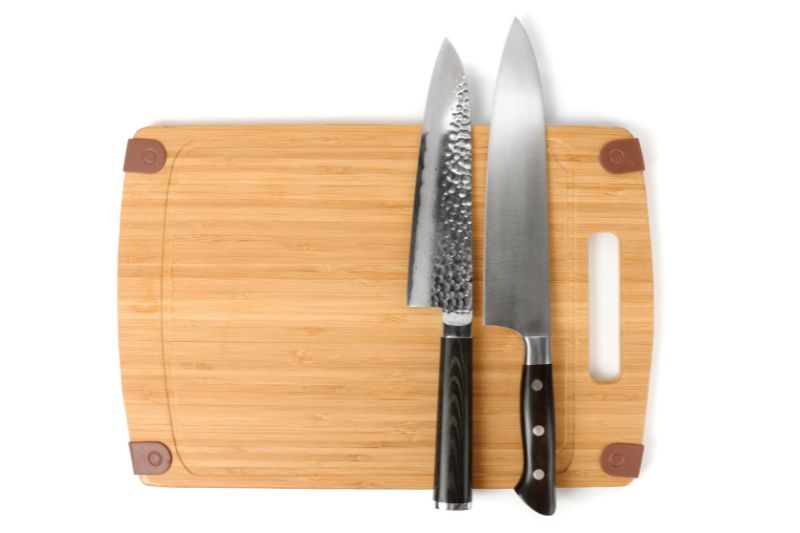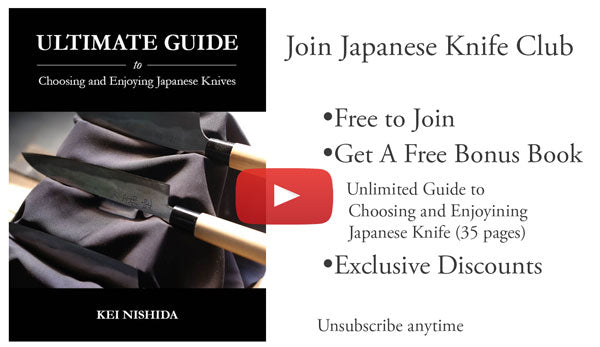With regard to the global cream of the crop in terms of cutlery, two European regions stand out for their reputation as mass producers of high-quality knives: Solingen in Germany and Thiers in France. While these two used to dominate the market when it came to Western-style knives, this is no longer the case as the Japanese have presented competition with their excellent selection of Western-style knives.
French Thiers Knives
Still, the German and French knife brands are rooted in tradition and reputation. The Thiers knives indeed maintain their stature in the industry.
When it comes to tradition, Thiers has it in spades. Its medieval blacksmiths left a long-lasting legacy. Sometime between the 13th and 15th centuries, Thiers, a commune of Auvergne in central France, started crafting the fine kitchen, table, and pocket knives that the town is known for today.
In modern times, Thiers is considered a major historical center of knife manufacturing, serving as headquarters to around a hundred companies as well as a cutlery museum. To be a Thiernois cutler is a proud occupation involving 700 years of knowledge and craft.
In the early 1990s, Thiers cutlers united to create a knife that symbolized and reflected the mastery of their town, and thus were Le Thiers knife and the Brotherhood of Le Thiers knife born.
In the more than 20 years that Le Thiers knife has stood as the emblematic knife of French cutlery, it has become available in many versions. Although these are created by different companies that belong to the brotherhood, they are produced in careful accordance with the established specifications of their organization.
Le Thiers knives can be in the form of pocket, table, or kitchen knives. You can identify a Le Thiers knife by the recognizable logo with the distinctive T right on the blade. It would state Le Thiers followed by “par *the brand that manufactured it,” e.g. Le Thiers par Neron.
Japanese Knives
Japan is also a country recognized for its historical knife craftsmanship. The Japanese have their own traditional knives, but since the inclusion of Western-style knives among their products, they have also established a reputation for being an excellent source for these.
The Japanese put their own mark in their version of Western-inspired knives. For instance, while they also make double-beveled blades like French Thiers knives, they have engineered an uneven style that achieves an outstanding sharpness similar to their traditional single-edged design.

Click here to learn more about the differences between single vs double bevel articles I wrote here.
The Japanese Western-style knives may look very closely like European-produced knives, but they bear subtle dissimilarities that make a world of difference. What are these?
The Main Distinctions
Both the Japanese knives and French Thiers knives are known for their quality and craftsmanship. Both types of knives are used by professional chefs and home cooks alike, but there are some key differences between them.
The Kind of Steel
One of the main differences between Japanese knives and French Thiers knives is the steel used to make them. Japanese knives are typically made from high-carbon steel, which is known for its sharpness and ability to hold a fine edge.
There's a caveat, though. As a rule, the harder the steel, the more prone it is to breaking. The lower flexibility more easily results in damage from the wrong movement. Also, harder steel is more difficult to sharpen. Generally, Japanese knives are better honed with a ceramic sharpening stone instead of a honing steel.
Nonetheless, science and art back this choice of harder steel. The asymmetrical angled edged design cannot be held by a softer kind of steel. Attempting the sharpness achieved by these angles would crack or chip a lower-grade steel.
On the other hand, French Thiers knives are typically made from a softer, more flexible stainless steel. This steel is more durable as well as resistant to rust and corrosion, but it is less sharp than high-carbon steel. While it's purported to be longer-lasting and more versatile, it also calls for more frequent honing.
Although traditional Japanese knives are made of carbon steel, many Japanese knives are now made with various materials similar to stainless steel, like French Thiers. An example is our CM Rust-Resistant Stainless Special Alloy Steel.
The Blade Edge
As mentioned, an important difference between these two types of knives is the way they are sharpened. Japanese knives are sharpened at a much steeper angle than French Thiers knives. This makes them sharper and more precise but also more delicate and prone to chipping if not executed with Japanese knife-making mastery.
On the other hand, French Thiers knives are sharpened at a shallower angle, making them more durable and resistant to chipping but also less sharp. This means that you encounter more resistance during use.
This V-shaped blade may not be as sharp, but it’s more convenient to resharpen. A 50:50 edge is easy to achieve. It is also easily manageable no matter the user’s dominant hand. This is not the case for Japanese blades, which are designed for right-handed users. However, many manufacturers produce Japanese Western-style models that can be re-ground for left-handed users like us.
Compared to other European chef's knives, the French version often has a straighter blade edge along the heel, but it curves up toward the point, creating a more triangular shape. Japanese knives could manifest a similar profile to French knives but would be thinner in the cross-section.


The Knife Handle
In terms of design, Japanese knives have a more minimalist and traditional look, with a simple, straight handle and a long, thin blade. On the other hand, French Thiers knives have a more ornate and traditional look, with a curved handle and a thicker, more robust blade. They also boast a full-tang construction.
The tang is the steel part that extends from the blade and secures itself into the handle. Full tang means that the steel of the blade runs all the way to the other end of the knife, following the shape of the handle as well.
Japanese knives typically have a hidden-tang construction, meaning the steel is embedded only partway into the handle. In the past, Japanese Western-style knives were also made with Western-style handles, but they have since adopted the lighter hidden-tang design. Japanese kitchen knives usually also come with a wooden handle, which needs to be maintained with oil or wax treatment. On the other hand, French Thiers knives come in a wider variety of handle materials.


The Overall Weight
Considering the combination of their different features (thinner blade, hidden tang, etc.), Japanese knives are typically lighter in weight than French Thiers knives. This makes them easier to handle and maneuver but also less durable and more prone to damage. Meanwhile, French Thiers knives are typically hardier but slightly more challenging to handle and utilize for its heavier weight.
The Usage
In terms of purpose, Japanese knives are frequently used for slicing and cutting raw fish and meats, while French Thiers knives are primarily used for chopping meat and crushing fruits, vegetables, and herbs.
Many chefs and home cooks find it worthwhile to invest in a combination of both. For instance, you may use a French knife for hard chopping and cutting beef and a Japanese knife for slicing and portioning fish if you want to optimize the best attributes of each kind.
Summary
In conclusion, Japanese and French Thiers knives are both high-quality, making them well-regarded worldwide. However, some notable differences exist between them, including steel type, design, and weight. In addition, each type of knife has its own unique set of characteristics that make it better suited for certain tasks, and it ultimately comes down to personal preference.
Get Free Bonus Books

Sign up for free to the Japanese Knife Club to get advice and exclusive articles about how to choose Japanese Knives, and tips and tricks for using Japanese knives.
About the author
Kei Nishida
Author, CEO Dream of Japan
Certification: PMP, BS in Computer Science
Education: Western Washington University
Kei Nishida is a passionate advocate of Japanese craftsmanship, a writer, and the founder and CEO of Japanese Knife Co., Japanese Green Tea Co., and Japanese Coffee Co., all part of Dream of Japan.
His journey began with a mission to introduce the world to the exquisite flavors of Japanese green tea. Through Japanese Green Tea Co., he pioneered the import of premium tea grown in nutrient-rich sugarcane soil, earning multiple Global Tea Champion awards. He then expanded into the world of coffee, launching Japanese Coffee Co., the first company to bring Sumiyaki charcoal-roasted coffee to a global audience.
With a deep appreciation for Japanese artistry and tradition, Kei turned his attention to one of Japan’s most revered crafts: bladesmithing. Through Japanese Knife Co., he made handcrafted katana-style knives, created by a renowned katana maker, available outside Japan for the first time. These exceptional knives embody centuries of samurai sword-making expertise, blending tradition with modern functionality for chefs and collectors alike.
Kei’s journey continues as he uncovers and shares Japan’s hidden treasures—one sip, one blade, and one legacy at a time.























